
Notes From Marinda
Canning Time
It used to be 4th of July when I would make apricot jam – starting back in the 70’s. With the drought in California, the fruit has ripened earlier in the last few years. Now it’s the beginning of June for ripe apricots. I get them from my “fruit dealer” at the local farmers market. I order a couple cases and get started.
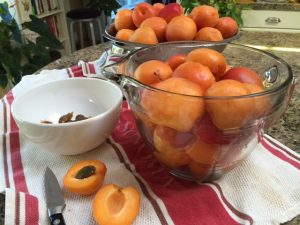
First step is cutting the apricots in half and measuring ten cups for a batch – with some halves going in my mouth. Ripe apricots are so good! Ten cups is the largest a batch can be. If you make a smaller batch, it will take less time to cook down.
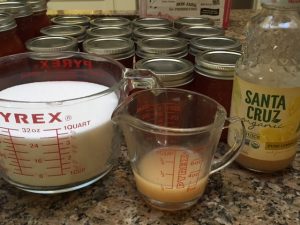
I add about 3 1/2 cups sugar and 1/4 cup lemon juice and set it on low for the sugar to melt with the fruit. Old recipes recommend more sugar, usually 1 to 1 or 2 to 1 fruit to sugar. There’s a fine line regarding how much sugar to use. Sugar is the preservative. If you don’t use enough sugar, it won’t keep. I have tried coconut sugar (aka palm sugar) that has a low glycemic index but it masks the taste of the fruit.
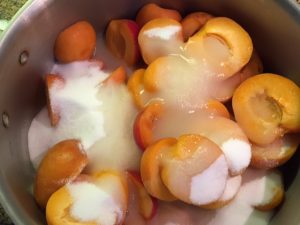
Once the sugar has started to melt into liquid with the fruit, stir it up, turn up the heat and start it cooking. Bring it to a boil.

As it starts to get thicker, you will need to stir it more frequently so it doesn’t stick to the bottom – and turn down the heat.
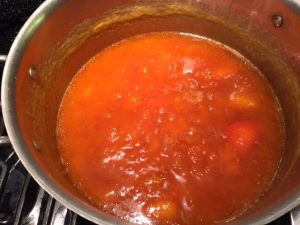
Continue simmering until it is ready. How do you tell when it ‘s ready? I put small plates in the freezer. When I think it’s about ready, I put a dollop on the plate and stick it back in the freezer. Once it’s cooled, I check it. If it’s not runny and is fairly thick- like jam – it’s ready to can.
With a wide mouth funnel, I fill the jars – pints and half pints. I put the lids in a small pot with water and bring it to a boil – so the seals are warm. With a wet paper towel, I wipe the rim of each jar to insure a clean seal. Put a lid on each jar. I love using using a lid lifter with a magnet to fish out each lid from hot water in the small pot. Screw the ring on tight – using a jar wrench to hold the jar – as it’s too hot to hold.
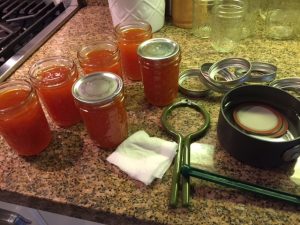
Next, process in a hot water bath – it’s the large pot shown here. I start the getting the water hot in the large canning pot when I start cooking the fruit. When it comes to a boil, I’ll either turn it off or turn it to low. Place the jars in the rack and lower in the hot water. The water needs to cover the jars by about an inch. Cover the canning pot and bring it back to a boil. Boil for 10 minutes. Lift the rack up and use a jar lifter to pick the jars up and set on the counter to cool. I always love hearing the pop as the jars cool. It’s a sign they are sealed.
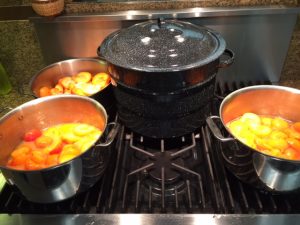
With another case of apricots, I made apricot chutney and one batch of apricot butter – per my daughter’s request. I’ll share these recipes another time!
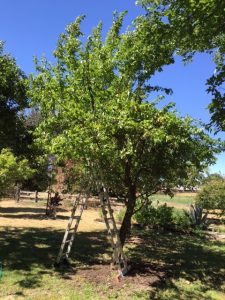
By the middle of June my friend’s Santa Rosa plum tree was filled with ripe plums. Time to make plum jam.

It’s the same process as the apricots – about 3 1/2 cups of sugar and 1/4 cup lemon juice to 10 cups plums. Plums are juicier than apricots so the sugar can be stirred right in and then turn up the heat to get them boiling.
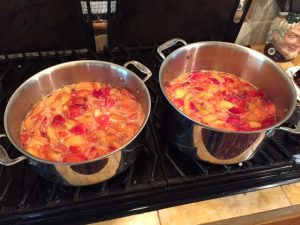
As the plums cook and start to thicken, the color gets deeper. Gorgeous color, right?
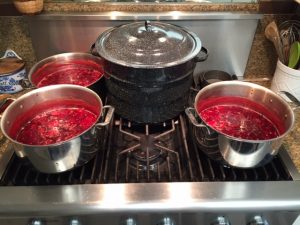
I love the tartness of the Santa Rosa plum that comes from the skin. Yum!


